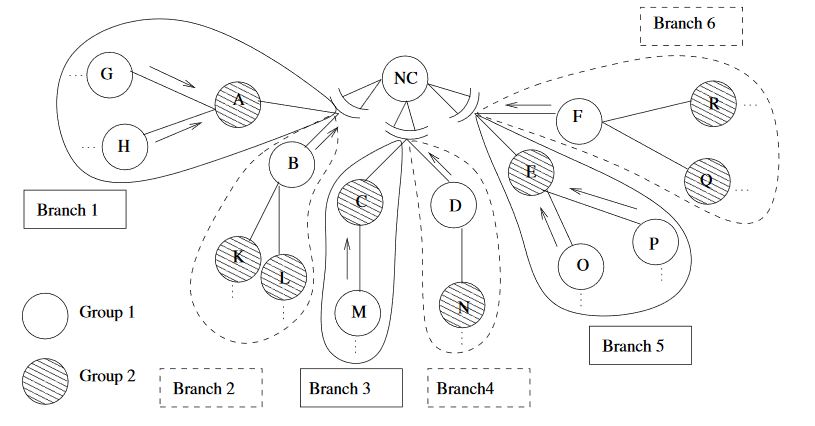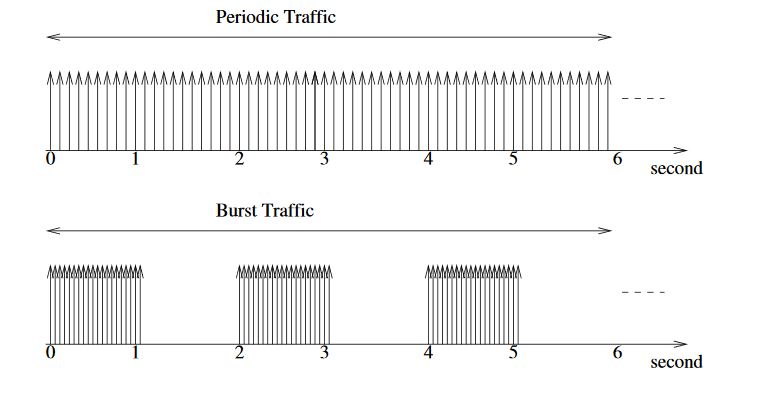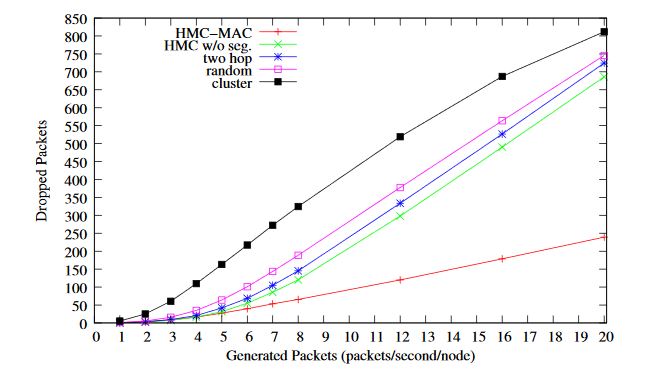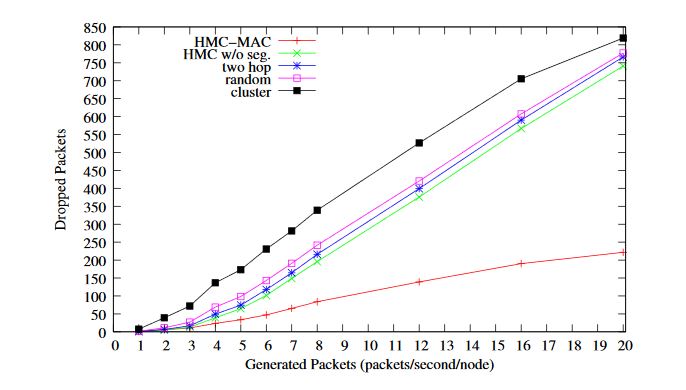ABSTRACT
Using multiple channels in wireless sensor networks helps increase the overall throughput and avoid interferences. In addition, introducing multi-interface nodes further helps in increasing the packet delivery rate for those specific nodes. In this paper, we evaluate a channel allocation method based on neighborhood discovery up to 3 hops and a hybrid MAC protocol designed for high data rate wireless sensor networks.
We propose a network segmentation that takes into consideration the existence of multi-interface sink in order to further increase to packet delivery ratio. Our protocol, called HMC-MAC, uses Time Devision Multiple Access (TDMA) for sequencing nodes activity, and Carrier Sense Multiple Access (CSMA)/CA with Frequency Devision Multiple Access (FDMA) for simultaneous data exchange. We evaluated our method using NS2 simulator and results show that HMC-MAC protocol improves the overall network performance compared to other protocols especially with high data rate and burst traffic.
STATE OF THE ART
In authors propose MASN, a new multi-channel allocation protocol for hierarchical ZigBee/IEEE 802.15.4 networks corresponding to realistic situations where the number of nodes is less than 50 with a hierarchical routing and many-to-one transmissions. The main goal is to improve the bandwidth. The unslotted CSMA/CA access method is used. In MASN, assignment of the different channels is centralized and distributed by the coordinator by using a function designed to calculate the channel offset between two successive children. The proposed channel assignment algorithm is inspired by the hierarchical address assignment process used in ZigBee.
HMC-MAC PROTOCOL

Figure 2. 3-hop neighborhood interference in channel allocation with acknowledgments`Figure 2. 3-hop neighborhood interference in channel allocation with acknowledgments
In order to avoid interference when acknowledgments are used, 3-hop neighborhood needs to be discovered. In we discussed why that the reuse of channels should be considered up to 3-hop neighborhood to avoid collisions and interference when immediate MAC layer acknowledgments are used. Figure 2 shows an example of how the use of the same frequency channel by a 3-hop neighbor might cause a collision. Nodes A and D are 3-hop neighbors using the same channel.

Figure 3. Network segmentation. Each interface divides its descendants into two branches
In order to increase the throughput, the NC should remain in reception mode and the nodes in depth 1 should should alternate between sending mode and reception mode in order to keep part of them in transmission mode. Thus, we divided the network into two groups (Figure 3), Group 1 includes odd depth nodes that are descendants of an even child of an interface (B, D, F are even children of an interface), and also includes even depth nodes that are descendants of an odd child of an interface.
PERFORMANCE EVALUATION

Figure 6. Traffic generation in periodic and burst modes
With both traffic generation profiles we reach the same number of generated packets. But, in the burst generation, nodes compete much more to access to the medium for 50% of the time compared to the periodic generation and spend the other 50% to forward packets accumulated in the packet queue. This results in higher offered load during the first 50% compared with the periodic traffic. Indeed, the same number of packets is generated in 50% of the time. Figure 6 shows how traffic is generated in both modes.

Figure 15. Number of dropped packets for periodic traffic

Figure 16. Number of dropped packets for burst traffic
Figures 15 and 16 present the results in terms of number of dropped packets. According to the CSMA/CA algorithm of the IEEE 802.15.4 standard, the frame is repeated four times and is dropped if it is not acknowledged or not sent after the fourth repetition. For higher traffic rates, we obtain a higher dropped packet rates as we have more packet loss and more repetitions. For periodic traffic generation, we note that HMC-MAC reduces the number of dropped packets compared to other protocols.
CONCLUSION AND PERSPECTIVES
In this paper, we evaluated under high data rates the performance of HMC-MAC, a hybrid multi-channel MAC protocol for WSNs. It is based on 3-hop neighborhood channel allocation to avoid interference when data frame acknowledgements are used. We evaluated by simulation the efficiency of HMC-MAC and compared it to other MAC protocols. We considered the packet delivery rate, the number of collisions, frame repetitions, and dropped packets ratio as the main metrics.
Results showed how HMC-MAC considerably reduces the number of collisions and frame repetitions compared to the other methods, and this in two different traffic scenarios and different random network topologies. HMC-MAC copes much better than the other protocols when we increase the offered load, this is even more obvious when we use a burst traffic generation. In the current version of HMC-MAC, the beacon propagation period is done in a pure TDMA fashion where each node has its own slot for broadcasting the beacon frame.
In our future work, we plan on optimizing this period by reducing it using a mix of TDMA and FDMA based on the neighborhood discovery information. Also, we plan on optimizing the frequency of this period in order to limit the control traffic overhead. A trade-off should be found between the clock drift for maintaining synchronization between nodes, the dynamic aspect of the network in order to take into account new nodes joining the network and nodes leaving the network, and the control traffic overhead. Managing node failure in the current version of the protocol is not yet considered.
One of the enhancements for HMC-MAC would be to consider redundant links to maintain connectivity and network activity in case of a node failure. In this paper, we did not optimize the routing protocol in order to achieve load balancing in the network. Hence, we observed a high rate of queue overflow because of the limited storage capacity of the packet queues especially on the nodes located near the sink. In our future works, we will investigate this point and try to achieve a better traffic load balancing to avoid queue overflow near the sink.
Source: Clermont University
Authors: Gerard Chalhoub | Rana Diab | Michel Misson
>> More Wireless Sensor Networks Projects Abstract for Engineering Students
>> More Wireless Projects Implementation in Ns2 for Engineering Students
>> More Wireless Projects Using Zigbee for Final Year Students